

Yosemite West Property & |
Don and Kay Pitts invited all Yosemite West property owners to a party and community meeting held on Sunday, December 14, 2003 at 2 p.m.
From Don and Kay Pitts:
The recent fires in Southern California made all of us aware of just how easy it is for entire neighborhoods to burn up. We would like to get a discussion started on how best to protect our community. Though there are many fire issues in Yosemite West, we would like to keep the discussion focused on protecting our community's borders through fuel reduction. As most of you know, the National Park Service did a major fuel reduction - 300 feet wide on the national park's boundary. Mike Beasley of NPS will be here to explain how NPS can help us protect our remaining perimeter.
Michael Beasley, NPS Prescribed Fire/Fuels Specialist (telephone: 209-375-9574; cell phone: 209-742-8990; email: Michael_Beasley@nps.gov) met with Yosemite West residents at an open community meeting on Sunday, December 14, 2003 (hosted by Don and Kay Pitts).
During 2003, the National Park Service (NPS) did a major fuel reduction - 300 feet wide on both sides of the Big Oak Flat Road - by creating and burning more than 20,000 piles of accumulated surface fuel and very small trees, otherwise known as "ladder fuels". Mike explained that removal of this fuel strata reduces the risk of fire getting into the forest canopy.
Mike explained that NPS plans to work in Wildland/Urban Interface (WUI) areas, and that the western and northern boundaries of Yosemite West are a WUI area of major concern. View a color topographic map of the Yosemite West Wildland/Urban Interface. For further information about NPS fire-related projects, please refer to the Draft Yosemite Fire Management Plan.
Mike also explained to those present how the NPS can help Yosemite West property owners protect the perimeter of the community that is most vulnerable to fire. He recommends that Yosemite West establish a Yosemite West Fire Safe Council. For information about what a fire safe council does, visit The Fire Safe Council website.
According to Mike, the first step to reduce the fire danger in Yosemite West is to remove the accumulated surface and ladder fuels in a 300-foot wide swath along the western and northern perimeter of Yosemite West. For NPS to do this, Mike said a Memorandum of Understanding (MOU) would need to be signed by the property owners and NPS. Since the perimeter adjacent to Yosemite West is owned by the developers, that corporation should be the first signatory of the MOU. Don Pitts has talked with the corporation's representative, who indicated to Don that they are ready to do so.
Mike also provided a sample document with contract specifications for the recent NPS Big Oak Flat roadside thinning treatment. A similar document would be required for any thinning project in Yosemite West. The most relevant points in the Specifications for Wildland Urban Interface Phase 1B Thinning are C.1. through C.5.
The next step would be for all property owners whose land lies on the western and northern perimeter of Yosemite West to also sign the MOU. The NPS can then (in all likelihood at no cost to property owners) remove accumulated fuels and very small trees. If a property owner does not want a specific tree removed, then the owner can tag it and NPS crews will not remove it. Any property owners who do not sign the MOU would not have their property treated by NPS.
A newly established Yosemite West Fire Safe Council (YWFSC) would meet to craft an MOU, using models that Mike Beasley provides. The hope is that the first phase can begin in summer 2004. The YWFSC would also draft a letter to all property owners, explaining the NPS offer to remove dangerous accumulations of surface and ladder fuels at no cost, and ask property owners to sign the MOU. The hope is that the second phase of removing dangerous fuels on perimeter owners' property could take place in summer 2005.
The third phase would be to remove fuels from all owners' property, which would follow after the buffer zone and the perimeter lots are cleared.
Below are some "Before" and "After" images of what NPS would be doing. Think of how nice your property would look, and of how much safer your property and all of Yosemite West would be.
| Before & After Images: Reducing Surface Fuels | |
|---|---|
Workers make burnable piles by cutting and collecting wood and surface debris. |
|
| Before | After |
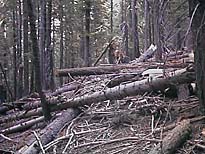 |
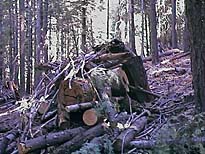 |
| Before | After |
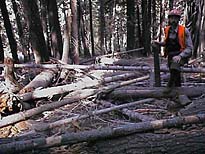 |
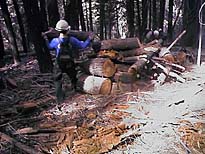 |
| Before | After |
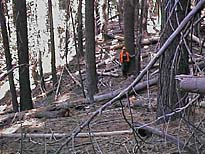 |
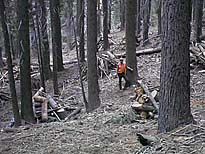 |
| Before | After |
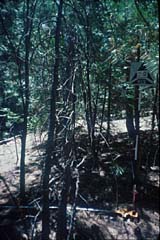 |
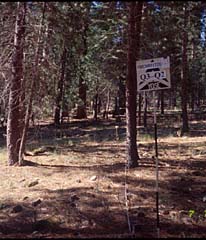 |
| Before | After |
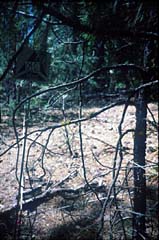 |
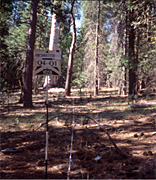 |
| Equipment Used in Reducing Surface Fuels | |
|---|---|
|
The NPS could make the ATV Arch available for the surface fuel reduction project on the perimeter of Yosemite West. Large surface timbers can then be piled into a "deck" for removal. |
|
| ATV Arch Used to Drag Logs | ATV Arch Dragging Log |
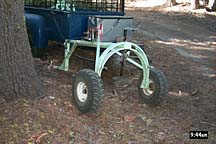 |
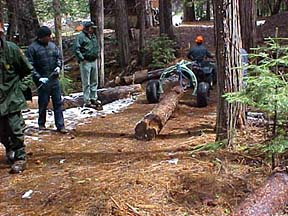 |
| Firewood deck stacked and ready for removal |
|
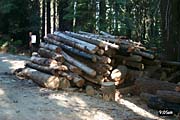 |
|
Here are links to two tables within the new NPS Fire Management Plan that indicate restoration and maintenance target conditions for different vegetation types within Yosemite National Park:
Restoration targets are largely structural in nature, as the NPS whittles away through fire and thinning to get to a healthy state. The maintenance targets are more about ecosystem process (e.g., the frequency of fire). This is the condition that future generations will hopefully witness on the landscape.
Back to << Fire Safety in Yosemite West
 Copyright text © Yosemite West Property & Homeowners, Inc. 2003-2012, Copyright photographs © John Mock 2004-2012. All rights reserved. Unauthorized redistribution of this document is prohibited. Updated February 7, 2012. |